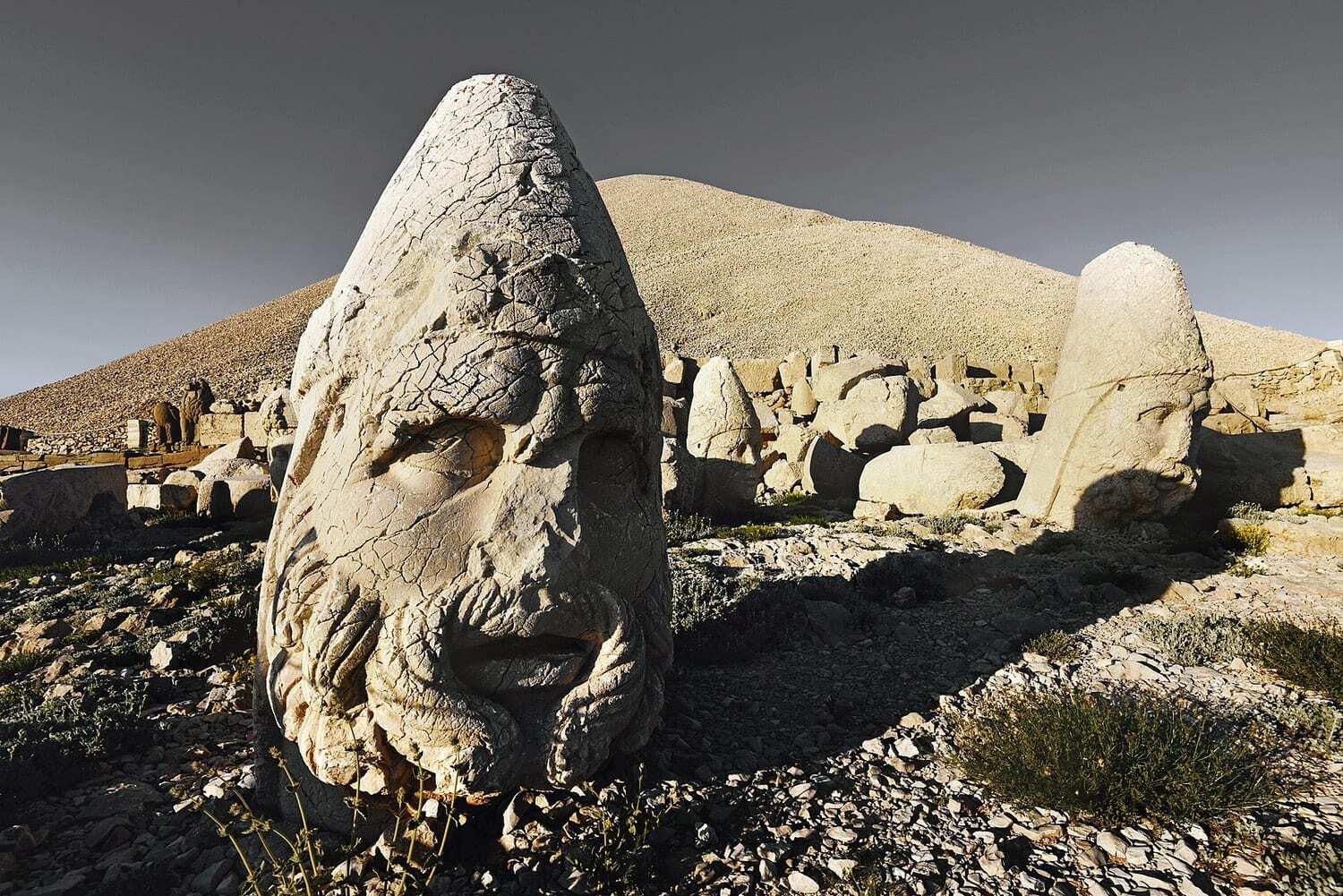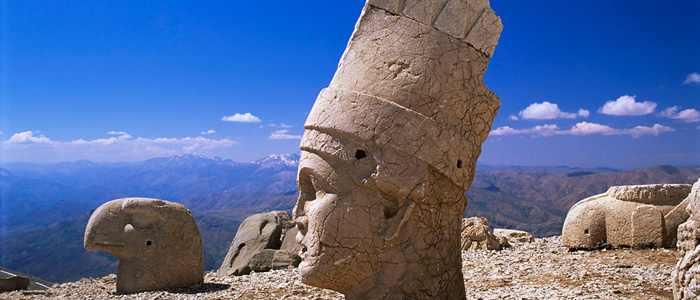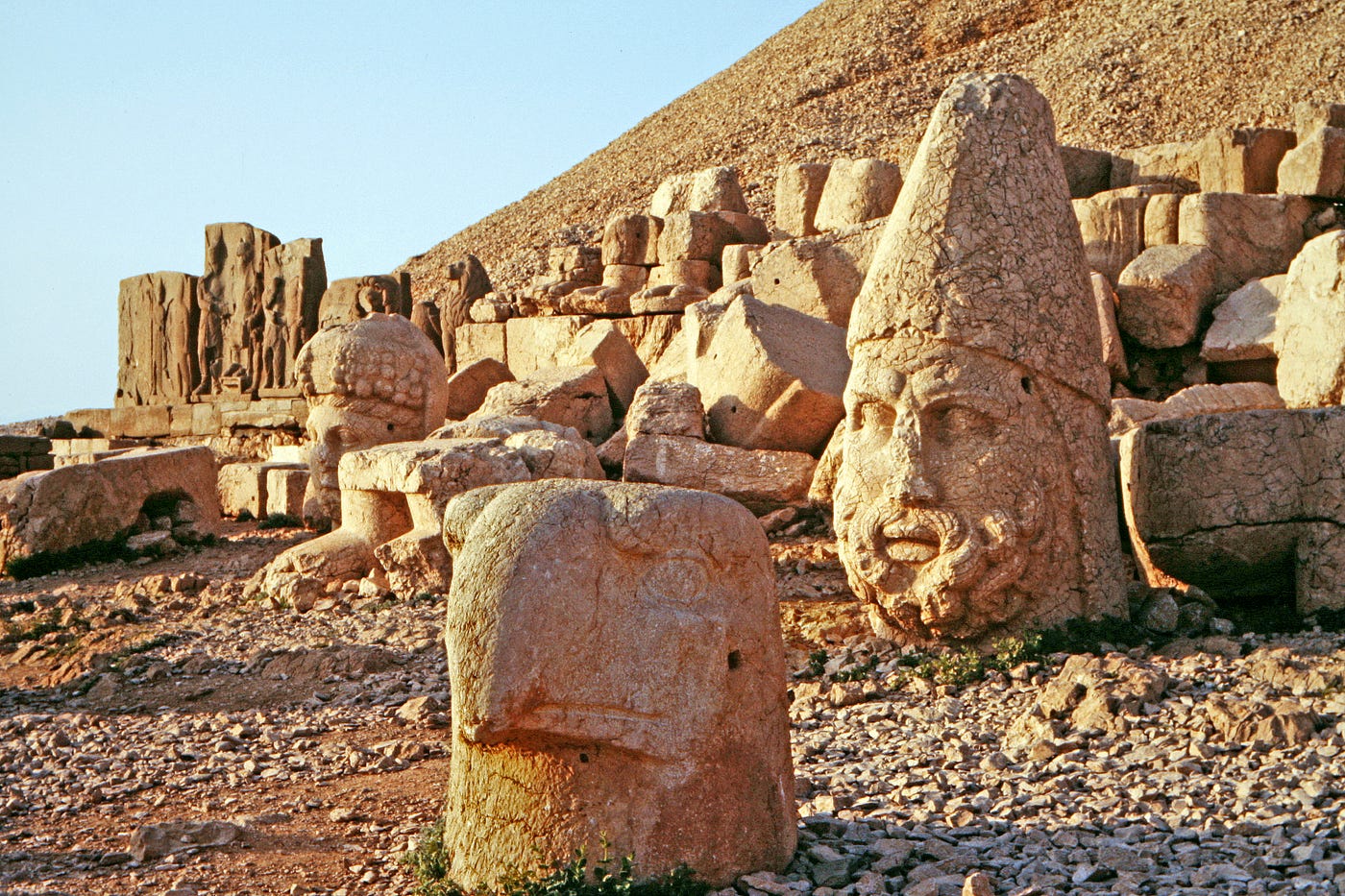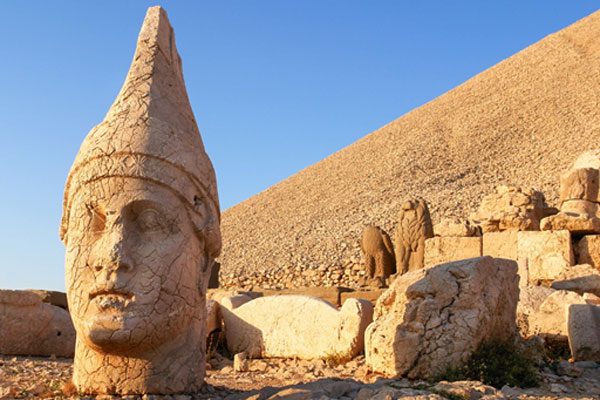Gods & Giants: Rise to Mount Nemrut's Majesty

Mount Nemrut is a fascinating archaeological site located in Turkey that attracts visitors from around the world. This ancient site is known for its monumental statues and impressive tomb-sanctuaries, which have a rich historical and cultural significance. If you're interested in history and want to explore an extraordinary place, the Gods & Giants: Rise to Mount Nemrut's Majesty tour is the perfect choice.
Overview of Mount Nemrut and its historical significance
Mount Nemrut, also known as Nemrut Dağ, stands at an elevation of 2,134 meters (7,001 ft) and is part of the Taurus Mountains in southeastern Turkey. It was built during the 1st century BC and was believed to be a royal tomb and sanctuary for King Antiochus I. The site is recognized as a UNESCO World Heritage site and is considered one of Turkey's most important historical sites.
The monumental statues at Mount Nemrut are truly awe-inspiring. Each statue is about 8-9 meters (26-30 ft) and represents ancient gods and kings. The heads of these statues have fallen from their original positions and now rest at the feet of their respective bodies, adding to the mystical atmosphere of the site.
Explanation of the Gods & Giants: Rise to Mount Nemrut's Majesty tour
The Gods & Giants: Rise to Mount Nemrut's Majesty tour offers a unique opportunity to immerse yourself in the history and culture of this incredible site. With this tour, you'll have knowledgeable guides who will explain the historical significance of Mount Nemrut and its statues.
During the tour, you'll have the chance to explore the various terraces and see the statues up close. You'll also learn about the symbolism behind each statue and the stories they represent. The tour will provide you with a deep understanding of the ancient civilization that thrived in this region.
Additionally, the tour offers breathtaking views of the surrounding landscape, allowing you to appreciate the area's natural beauty. As you climb to the summit of Mount Nemrut, you'll be rewarded with panoramic views of the surrounding mountains and valleys.
The Gods & Giants: Rise to Mount Nemrut's Majesty tour is a must-visit for history enthusiasts and those who appreciate ancient architecture. This tour offers a unique opportunity to explore the fascinating site of Mount Nemrut and learn about its historical significance. Don't miss the chance to witness this ancient civilisation's grandeur and the surrounding landscape's breathtaking beauty.

The Ancient Kingdom of Commagene
Background information on the Kingdom of Commagene and its rulers
The Kingdom of Commagene was a small independent kingdom that existed from the 1st century BC to the 1st century AD. It was located in modern-day southeastern Turkey and was ruled by a dynasty of kings from the royal House of Commagene.
The most famous ruler of Commagene was King Antiochus I, who played a significant role in the construction of Mount Nemrut. He believed himself to be a descendant of both Greek Macedonian and Persian royalty, and he sought to combine elements from both cultures in Commagene.
Commagene's cultural and religious fusion
One of the most interesting aspects of Commagene's culture was its unique blend of Greek and Persian influences. This fusion was evident in the religious practices of the kingdom. The people of Commagene worshipped a combination of Greek and Persian deities, including Zeus-Oromasdes and Heracles-Artagnes.
The statues found at Mount Nemrut also reflect this cultural fusion. The colossal statues depict Greek and Persian gods and kings, with influences from both cultures evident in their attire and attributes. This blending of cultures showcased Commagene's desire to establish a distinct identity.
Additionally, Commagene was known for its vibrant artistic scene. The kingdom produced exquisite sculptures, reliefs, and inscriptions, reflecting the skill and creativity of its artisans.
The Kingdom of Commagene was a fascinating ancient kingdom that thrived in southeastern Turkey. Its rulers, particularly King Antiochus I, left a lasting legacy with the construction of Mount Nemrut. The fusion of Greek and Persian influences in Commagene's culture made it a unique and significant civilization in its time. The Gods & Giants: Rise to Mount Nemrut's Majesty tour allows visitors to immerse themselves in the rich history of Commagene and explore the magnificent archaeological site of Mount Nemrut.

Exploring Mount Nemrut
Description of Mount Nemrut's location and physical features
If you're a history enthusiast or simply love exploring ancient sites, visiting Mount Nemrut is a must on your travel bucket list. Located in modern-day southeastern Turkey, Mount Nemrut is an archaeological site once the centrepiece of the ancient Kingdom of Commagene.
Sitting at an elevation of 2,150 meters (7,050 feet), Mount Nemrut is known for its majestic statues and breathtaking views. The site is nestled amidst the stunning Taurus Mountains, adding to its natural allure. It's worth noting that the temperature at the summit can be quite cool, even during the summer months, so be sure to bring a jacket or sweater.
Guided tours and hiking options
When visiting Mount Nemrut, joining a guided tour is highly recommended. These tours provide valuable insights into the history, culture, and significance of the ancient Kingdom of Commagene. Knowledgeable guides will lead you through the site, explaining the stories behind the statues and reliefs.
For those who enjoy hiking, there is also the option to trek up to the summit of Mount Nemrut. This challenging but rewarding experience allows you to immerse yourself in the natural beauty of the surrounding landscape. As you make your way to the top, you'll have the opportunity to appreciate the grandeur of the colossal statues up close.
Whether you choose a guided tour or embark on a hiking adventure, visiting Mount Nemrut is a memorable experience. You'll be able to witness firsthand the remarkable fusion of Greek and Persian cultures and enjoy the awe-inspiring scenery surrounding this ancient site.
Come and uncover the secrets of the Kingdom of Commagene as you explore Mount Nemrut, a place where history and nature intertwine.

The Sculptural Ensemble
Overview of the monumental statues and sculptures at Mount Nemrut
The sculptural ensemble at Mount Nemrut consists of massive stone heads and statues, each weighing several tons. These imposing figures are believed to represent a fusion of Greek and Persian influences, reflecting the cultural diversity of the ancient Kingdom of Commagene. As you stroll through the site, you'll be amazed by these ancient sculptures' intricate details and craftsmanship.
What makes the sculptural ensemble at Mount Nemrut truly remarkable is its arrangement. The statues are strategically placed in a way that creates a dramatic effect, especially during sunrise and sunset. This positioning was intentional, as it was believed to symbolize the eternal resting place of the Gods and Giants.
Meaning and symbolism behind the Gods & Giants
The colossal statues at Mount Nemrut are not just impressive works of art; they also serve as a powerful symbol of the ancient beliefs and ideology of the Kingdom of Commagene. The statues are thought to depict various deities and rulers, representing the notion of divinity and the connection between mortals and the gods.
In addition to the gods, the statues also portray figures known as Giants. These Giants were believed to be mythical creatures, embodying strength and power. The significance of these Giants and their role in ancient mythology adds another layer of intrigue to the sculptural ensemble at Mount Nemrut.
As you explore this extraordinary site, you'll have the opportunity to learn more about the stories and legends behind each statue. Tour guides will provide valuable insights into the symbolism and significance of these ancient sculptures, allowing you to truly appreciate the rich history and cultural heritage of Mount Nemrut.
A visit to Mount Nemrut is a unique and unforgettable experience. Whether you're fascinated by history and art or simply love exploring breathtaking landscapes, this ancient site has something for everyone. Immerse yourself in the world of the ancient Kingdom of Commagene and witness the awe-inspiring beauty of the sculptural ensemble at Mount Nemrut.

The Gods of Mount Nemrut
Exploration of the colossal stone heads representing various deities
If you're fascinated by ancient history and love exploring extraordinary sites, then a visit to Mount Nemrut should be at the top of your list. This remarkable archaeological site, located in southeastern Turkey, boasts an impressive collection of colossal stone heads and statues depicting various deities. Prepare to be awe-struck as you discover the rich mythology and symbolism behind these magnificent sculptures.
As you wander through the site, you'll encounter massive stone heads unlike anything you've ever seen. These monumental figures, weighing several tons each, stand as a testament to the craftsmanship and artistic abilities of the ancient Kingdom of Commagene. The level of detail and intricacy in these sculptures is truly remarkable and will leave you in awe.
Each stone head represents a different deity, showcasing the diverse range of gods worshipped in the ancient kingdom. From the powerful Zeus to the majestic Apollo, you'll have the opportunity to learn about the characteristics and stories associated with each of these mythical figures. A knowledgeable tour guide will provide you with fascinating insights into the mythology and beliefs of the Kingdom of Commagene.
Characteristics and significance of the featured Gods
The stone heads at Mount Nemrut depict an array of gods, each with their own unique characteristics and significance. Let's explore a few features of the featured deities:
| God | Characteristics | Significance |
|---|---|---|
| Zeus | Mighty, thunder-wielding ruler of the gods | Symbolizes power and leadership |
| Apollo | God of music, poetry, and healing | Represents artistic and intellectual pursuits |
| Hercules | Half-god with immense strength and courage | Embodies heroism and physical prowess |
| Tyche | Goddess of fortune and prosperity | Symbolizes luck and abundance |
| Antiochus I | Ruler of the Kingdom of Commagene | Represents the divine connection between the ruler and the gods |
Each of these gods played a significant role in the belief system and ideology of the Kingdom of Commagene. The stone heads at Mount Nemrut provide a glimpse into the ancient kingdom's religious beliefs and the close ties between mortals and the divine.
A visit to Mount Nemrut is an unparalleled experience that allows you to step back in time and immerse yourself in the mythology and artistry of the Kingdom of Commagene. Whether you're a history enthusiast, an art lover, or simply seeking an adventure, the monumental statues and sculptures at Mount Nemrut will leave a lasting impression.

The Giants of Mount Nemrut
Description of the mythological giant figures at Mount Nemrut
If you're fascinated by ancient history and love exploring extraordinary sites, then a visit to Mount Nemrut should be at the top of your list. This remarkable archaeological site, located in southeastern Turkey, boasts an impressive collection of colossal stone heads and statues of mythological giants. Prepare to be awe-struck as you discover the rich mythology and symbolism behind these magnificent sculptures.
As you wander through the site, you'll encounter massive stone heads, unlike anything you've ever seen. These monumental figures, weighing several tons each, stand as a testament to ancient civilisations' craftsmanship and artistic abilities. The level of detail and intricacy in these sculptures is truly remarkable and will leave you in awe.
Connections to ancient legends and folklore
The giant figures at Mount Nemrut are not only beautiful works of art, but they also hold deep connections to ancient legends and folklore. These towering stone heads are believed to represent mythical beings that were renowned for their immense size and strength. Each figure has its own unique story and significance, adding to the intrigue and wonder of the site.
One such legend is the tale of the famous giant, Antaeus, who was said to be the son of the Earth Goddess, Gaia. Antaeus was known for his invincible strength as long as he remained in contact with the ground. By depicting these giants at Mount Nemrut, the ancient artists immortalized the tales of these legendary beings.
Another legendary figure depicted at Mount Nemrut is the giant Orion. In ancient Greek mythology, Orion was a mighty hunter who challenged the gods themselves. His stature and bravery made him a popular legend across various civilizations. The presence of Orion at Mount Nemrut further highlights the ancient kingdom's fascination with these mythological figures.
A visit to Mount Nemrut is not only a journey into the ancient past, but it is also an opportunity to explore the connections between mythology, art, and the human imagination. These colossal stone heads and statues are a testament to the creativity and beliefs of civilizations long gone, and they are sure to leave a lasting impression on anyone who visits.

UNESCO World Heritage Site
Explanation of the significance of Mount Nemrut's UNESCO World Heritage status
If you're someone who loves exploring ancient historical sites, then Mount Nemrut is a must-visit destination for you. This extraordinary archaeological site, located in southeastern Turkey, is a treasure trove of ancient sculpture and holds the prestigious status of being a UNESCO World Heritage Site.
The UNESCO World Heritage status is given to sites that are deemed to have outstanding universal value and are important for mankind as a whole. Mount Nemrut's inclusion on this list is a testament to its significance and the importance it holds in preserving our collective human history.
The giant figures and statues found at Mount Nemrut are not only masterpieces of art and engineering but also provide valuable insights into ancient civilizations and their cultural beliefs. These sculptures are a testament to the artistic skills and craftsmanship of the past and are evidence of the rich and diverse history of the region.
Efforts to preserve the site
The UNESCO World Heritage status brings global attention and recognition to Mount Nemrut, increasing efforts to preserve and protect the site for future generations. The designation ensures that the site receives the necessary funding, resources, and expertise to safeguard its unique cultural heritage.
Preservation efforts at Mount Nemrut include monitoring and documenting the condition of the sculptures, implementing conservation methods to prevent deterioration, and raising awareness about the site's historical importance among visitors and local communities.
Mount Nemrut is not just a tourist attraction but a site of immense cultural significance. The UNESCO World Heritage status serves as a reminder of the responsibility we have to safeguard and cherish our shared human heritage. By visiting Mount Nemrut and supporting these preservation efforts, we can contribute to this remarkable site's preservation and appreciation for future generations.

Local Culture and Traditions
Insight into the local communities residing near Mount Nemrut
When visiting Mount Nemrut, not only will you get to explore its remarkable archaeological site, but you will also have the opportunity to immerse yourself in the vibrant local culture and traditions of the communities living in the vicinity. The people residing near Mount Nemrut are known for their warm hospitality and deep connection to their heritage and land.
The local communities around Mount Nemrut have a rich history that can be traced back to ancient times. Their way of life reflects a blend of influences from various civilizations inhabited the region throughout millennia, creating a unique and diverse cultural tapestry.
These communities deeply respect nature and place great importance on sustainable practices. They understand the value of preserving their land and traditions and actively participate in initiatives to protect the environment and promote responsible tourism.
Traditional practices, cuisine, and festivals
One of the best ways to experience the local culture around Mount Nemrut is through their traditional practices and rituals. Many of these practices are centred around agriculture, as the communities rely heavily on farming as their primary livelihood. You can witness traditional farming methods, including cultivating local crops and producing traditional handicrafts.
The local cuisine is a delightful aspect of the culture, offering a taste of authentic Turkish flavours. You can savour delicious dishes prepared using locally sourced ingredients, including fresh produce, dairy products, and aromatic spices. Don't miss the opportunity to try traditional dishes like kebabs, baklava, and gözleme.
The local communities celebrate festivals and events throughout the year that showcase their traditions and customs. These celebrations often involve music, dance performances, colourful costumes, and local crafts. Attending these festivals will give you a deeper understanding of the local culture and allow you to partake in the joyous spirit of the community.
By engaging with the local communities and appreciating their culture and traditions, you will enrich your travel experience and support and contribute to preserving their heritage. Remember to respect their customs and embrace the opportunity to learn from their way of life.
